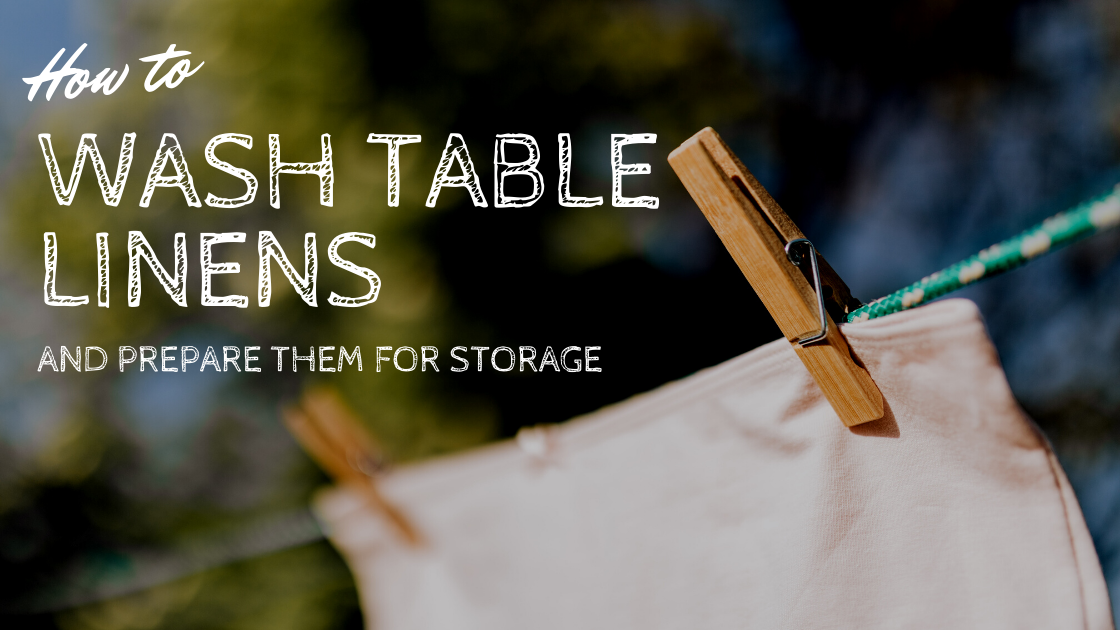How to Wash Table Linens & Prepare Them for Storage

Whether you use cloth table linens for everyday meals, special occasions, or big events, it’s important to store them in a way that preserves them for future use. A big step in keeping tablecloths, cloth napkins and other table linens beautiful over time is cleaning and removing wrinkles before properly storing them.
Cleaning and Care for Tablecloths
Tablecloths are available in many fabric options from easy-clean and wrinkle-free vinyl to machine-washable and wrinkle-resistant polyester to beautiful but high-maintenance cotton or linen. Let’s look at how to best prepare each tablecloth for storage.
Vinyl tablecloths:
Basic cleaning straightforward for this fabric, only requiring liquid soap and a damp cloth or sponge. Hanging the tablecloth in the sun can reduce the growth of mold and germs on its surface. Every once in a while, a vinyl tablecloth benefits from a thorough cleaning in the washing machine on the gentle cycle in cold water with mild detergent. Hang the tablecloth to dry. Be careful though, it’s easy to damage or ruin one during in-depth cleaning.
One question might be how to get creases or wrinkles out of a vinyl tablecloth. These should fall out in time, but for a quick fix or to rid yourself of stubborn crease there are options. You can put a vinyl tablecloth in the dryer on low heat with a couple of heavy towels, but you must remove it promptly after a couple of minutes before it gets too hot. You can also use a cool iron on vinyl, but be very careful with it. Rolling a vinyl tablecloth around or inside a tube is the best way to prep it for storage to prevent damage and wrinkles.
While vinyl tablecloths might seem like a sanitary option (just wipe them down after every use, right?) the fact is they tend to be rather unsanitary. Just how clean and sanitary was that rag you used to wipe it down? Did you use a sanitizer cleaner with it? Also, what’s in the hems of that vinyl table cover? Likely food and drink build up.
Vinyl is almost impossible to deeply clean in a quick and easy manner (it’ll get destroyed if you try to dry it in a dryer, plus washing machines really reduce its longevity). That’s why we recommend buying polyester or polyester blend tablecloths.
Polyester tablecloths:
Basic polyester tablecloths are fantastic options for everyday use or for large events. They are available in endless colors and patterns, so your selection is never limited. Plus, you can’t beat the ease of care for this option. Wondering how to wash a polyester tablecloth? Most polyester tablecloths are machine washable in any washing machine with regular detergent. Dry them on low heat, permanent press setting. Remove promptly to avoid wrinkles. Before putting the tablecloth into the wash, you should first treat or remove any wax or stain.
How to remove candle wax: First, scrape the excess wax from the tablecloth with the edge of a dull knife. Next, place a thin towel on either side of the tablecloth where the wax remains. Then, use either a hair dryer or iron to heat the wax, allowing the towels to absorb that which remains. After this step, you may see oily residue. Using a cloth, apply rubbing alcohol until the oil comes out.
Polyester Striped Tablecloth from iQLinens.com
The selection of polyester tablecloths from iQ Linens is huge! Get a tablecloth of any color to match your home décor or buy in bulk for weddings or other large events. These tablecloths are machine-washable and wrinkle, stain & flame resistant.
Linen or Cotton Tablecloths:
For the most formal of dinners many hosts will choose a linen tablecloth as the base for their table’s décor. The challenge of this fabric, as well as cotton tablecloths, is not only keeping them clean but also wrinkle free.
Linen tablecloths should be pretreated for any stains and washed on a gentle cycle in your home’s washing machine. After drying on low in the dryer, the best idea is to remove while damp, fold and put into the freezer overnight. This will make pressing it a breeze the next day. Be careful with dry cleaning because it can result in setting stains, which can ruin the tablecloth.
Caring for a 100% cotton tablecloth requires the same steps as a linen tablecloth for the most part. You want to include a cooldown cycle on its time in the dryer on low, and pull it from the dryer while it’s still a little damp, like when you feel it and you can tell whether it’s damp or cold. Over-drying a cotton tablecloth can cause it to shrink. A hot iron can be applied to rid the tablecloth from wrinkles, though not so hot as to scorch the fabric.
If you want the feel of cotton tablecloths, without the worries of the fabric shrinking or heavy wrinkling (both are common issues with cotton table linens) then we recommend a 50% cotton and 50% polyester blend. Our 50/50 PolyCotton blend fabrics are our Twill, Miranda, Melrose, and Saxony lines. Be sure to check them out of a better tablecloth option!
Cloth Napkins: Save the Planet Wrinkle Free
Many households are switching to reusable cloth napkins from generations of using paper. This is a cheaper option than continually buying napkins, cuts down on overall household waste and might save a few trees. There is also no better way to dial up the volume on an event’s formality than the use of crisp cloth napkins. Caring for these napkins to extend their use is easy, as long as you follow these tips.
Polyester Cloth Napkin Care:
Polyester or polyester/cotton blend napkins are the easiest napkins to use on a daily basis or for large events. They hold their color well through frequent washing machine and dryer cycles. These napkins will also hold their shape well and remain relatively wrinkle-free. Having a set for each day of the week can cut down on the need to wash as frequently, if you’re using them in your home. Once clean, you simply fold and store them in a dry space for their next use. Check out the polyester napkin selection of beautiful colors from iQ Linens.
Cobalt Basic Polyester Napkins from iQLinens.com
Caring for Cotton and Linen Napkins:
Sometimes an occasion is special enough to break out the fine cloth napkins made of linen or cotton. Caring for these napkins is a bit trickier. You can still wash and dry them in your home’s washer and dryer, but these fabrics require the gentle cycle with cold water and a turn on low in the dryer until slightly damp. Be very careful not to over-dry to avoid misshapen or shrunken results. Also, you can iron these napkins if needed. Linen requires a lower heat setting than cotton, and care needs to be taken to avoid scorching the fabric.
Following the correct steps to clean your table linens before storing them for their next use makes that next dinner or event a breeze. Remember that these tips for tablecloths and napkins can be applied to any table linens made of similar fabric. Visit our blog for 12 Table Linen and Dining Room Storage Ideas.
